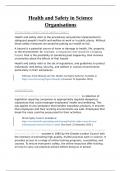Health and Safety in Science
Organisations
What does Health and Safety mean?
Health and safety refer to the procedures and policies implemented to
safeguard people's health and welfare at work or in public places. Without
these safety measures we would be putting our health at risk.
A hazard is a potential source of harm or damage to health, life, property,
or the environment, for example, a misplaced chair would be a tripping
hazard. Risk is the possibility of something bad happening. Risk involves
uncertainty about the effects of that hazard
Health and safety refer to the set of regulations, and guidelines to protect
individuals’ well-being, security, and welfare in various environments,
particularly in their workplaces.
Software, Tools Hazards and risk, Health, and Safety Authority. Available at:
https://www.hsa.ie/eng/Topics/Hazards/ (Accessed: 23 September 2024).
Legislations:
Control of substances hazardous to health (COSHH)- A collection of
legislation requiring companies to appropriately regulate dangerous
substances that could endanger employees' health and wellbeing. This
law applies to any workplace that handles hazardous products. It ensures
that employees and their working environments are safe. Employees that
break the rules could be prosecuted for their activities.
British Safety Council. Available at:
https://www.britsafe.org/training-and-learning/find-the-right-course-for-you/
informational-resources/what-is-coshh/ (Accessed: 23 September 2024 ).
Consortium of Local Education Authorities for the Provision of Science
Services (CLEAPSS)- founded in 1965 by the Greater London Council with
the intention of promoting high-quality, fruitful practical work in science. It
provides access to a range of online training programs, counselling, and
courses. To ensure everyone's safety, the online resources offer training
on how to carry out practical actions before doing so in person.
, What is CLEAPSS? Available at: https://science.cleapss.org.uk/Policies/What-Is-
Cleapss.aspx (Accessed: 23 September 2024).
The classifi cation, labelling and packaging of substances and mixtures
(CLP)- is a law from the European Union (EU) that monitors the transfer of
chemical dangers to workers and consumers. It assists clients in
understanding the meaning of various warning signals, which is critical to
the effectiveness of danger communication. In 2009, the CLP Regulation
was unveiled. It requires handlers to:
Classify: Name the hazards of the substance.
Label: Explain the hazards and how to avoid them
Package: Design packaging based on the hazards of the product it
holds.
Personal protective equipment (PPE)- anything that shields
the wearer from harm or illness, such as goggles, helmets, high-visibility
apparel, and clothing. Another kind of personal protective equipment
(PPE) that protects workers from inhaling dust, mist, gas, and fumes is
respirable protective equipment (RPE). It offers protection against a wide
range of threats, including heat, electricity, chemicals, biohazards, and
airborne particulates. PPE is provided at no cost on behalf of the
employers.
United Kingdom Accreditation Service (UKAS)- they are an organisation
appointed by the government, to assess organisations that provide
services including certification, testing, inspection, validation, and
verification. In short UKAS checks the checkers.
The UK accreditation body - creating confidence (2023) UKAS. Available at:
https://www.ukas.com/ (Accessed: 23 September 2024).
Display Screen Equipment (DSE)- is a general term for any device with a
screen that displays information. This includes laptops, computers,
tablets, smartphones, and touch screens. These rules do not apply to
people who use DSE for a brief period or infrequently.




